Conference Presentations by Ümit Hasan Gözkonan
II Business & Organization Conference, 2019
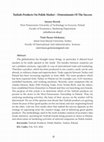
The globalization has brought many things, in particular it allowed local markets to be really op... more The globalization has brought many things, in particular it allowed local markets to be really opened to the world. The borders between countries are not a problem anymore, especially in case of international trade and marketing. Therefore a product, which has been produced in one country, easily can be seen abroad, in ordinary shops and supermarkets. Trade capacity between Turkey and Poland has been increasing regularly as from 2000. The main products which has been exported from Turkey to Poland are for example cars, LCD monitors, unshelled hazelnuts, and washing machines. Recently, some companies like an Atateks-Morera, Beko, DSD Foreing Trade, Evita Textile-BGN, and the others, have established firms (branches) in Poland and they are launching own brands. The purpose of this article is to determine which of the Turkish products are present in the stores in the West Pomeranian Voivodship in Poland. Then, by analyzing marketing activities, the basis of their success on the market will be determined. We are of the opinion (out thesis) that Turkish products are gaining clients because of their good quality on the one hand, and non-originating brand on the other. And our first results show that indeed the success depends on the strategy of separating from the country image, and of delivering good quality products. The methodology used in the work includes: analysis of secondary data (trade statistics), searching for Turkish brands being present in stores in Poland, and observation of marketing activities of selected companies on Polish market.
Books by Ümit Hasan Gözkonan
International Studies and Evaluations in the Field of Economics and Administrative Sciences, 2024
First InTraders International Conference on International Trade Abstract Book, 2018
First InTraders International Conference on International Trade Abstract Book
Papers by Ümit Hasan Gözkonan
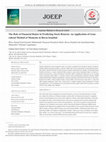
The Role of Financial Ratios in Predicting Stock Returns: An Application of Generalized Method of Moments in Borsa Istanbul, 2024
One of the main factors shaping the investment decisions of savers is the financial ratios of com... more One of the main factors shaping the investment decisions of savers is the financial ratios of companies. Indeed, the efficiency of financial markets and the effect of financial data related to companies on their stock performance have always been subjects of interest in the financial literature. This study investigates the effects of the financial ratios of the top ten companies listed on Borsa Istanbul that operate in the industrial sector on their stock performance. The recent ten quarters of data from the companies were included in the research, and the Generalized Method of Moments (GMM)-based Dynamic Panel Approach was applied as the research method. In the research model, Return on Assets (ROA), Return on Equity (ROE), Return on Invested Capital (ROIC), Debt/Equity Ratio (D/E), and Quick Ratio (QR) were defined as independent variables, while stock return was defined as the dependent variable. As a result of the study, it was determined that the ROA and D/E ratios have a negative effect on stock returns, while the ROE ratio has a positive effect.
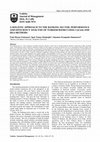
A Holistic Approach to the Banking Sector Performance and Efficiency Analysis of Turkish Banks Using CoCoSo and DEA Methods, 2024
The banking sector is a vital component of global economies, playing a critical role in ensuring ... more The banking sector is a vital component of global economies, playing a critical role in ensuring financial stability by gathering savings, providing credit, and facilitating various financial transactions. Banks not only support economic growth but also act as intermediaries between surplus and deficit units within the economy. Therefore, evaluating their financial performance and efficiency is crucial for understanding the overall health of the financial system. This study analyzes the financial performance and efficiency of the top 10 banks in Turkey, which are ranked by asset size, over a 10-year period from 2013 to 2022. Using the Combined Compromise Solution (CoCoSo) method, the study ranks these banks based on various financial criteria, such as capital adequacy, asset quality, liquidity, and profitability. CoCoSo is a multi-criteria decision-making method that allows for comprehensive performance analysis by considering multiple factors simultaneously. In addition to CoCoSo, Data Envelopment Analysis (DEA) is used to evaluate the efficiency of these banks in utilizing their resources to generate financial outputs. The study's findings reveal that privatelyowned banks, particularly Akbank T.A.Ş., consistently rank at the top in terms of both financial performance and efficiency. Akbank's strong performance is attributed to its effective resource utilization and strategic management decisions. State-owned banks, on the other hand, generally show lower financial performance, even though they exhibit high efficiency levels. This discrepancy suggests that public banks may be focusing on non-profit-driven projects that contribute to public welfare, which in turn affects their overall financial performance. Foreign-owned banks, such as Garanti Bankası and Denizbank, also demonstrate strong financial performance but show varying degrees of efficiency, with Denizbank being relatively less efficient in resource utilization. By employing both the CoCoSo and DEA methods, this study offers a unique dual-method approach that provides a comprehensive evaluation of the Turkish banking sector. The combination of these two methods allows for a more nuanced understanding of both financial performance and efficiency, offering valuable insights for policymakers, bank management, and researchers. The study not only highlights the strengths and weaknesses of individual banks but also underscores the importance of efficient resource management for sustaining competitive advantage in a highly dynamic banking environment. The results of this study can serve as a robust framework for future research on bank performance evaluation, especially in emerging markets. Moreover, the study's methodology can be applied to other sectors or countries to provide cross-sectional and time-series analysis, contributing to the broader literature on financial performance and efficiency.
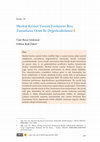
Güncel Finansal Gelişmeler ve Uygulamalar, 2024
Menkul kıymet yatırım fonları özellikle bilgi ve zaman kısıtına sahip tasarruf sahiplerinin yatır... more Menkul kıymet yatırım fonları özellikle bilgi ve zaman kısıtına sahip tasarruf sahiplerinin yatırımlarını değerlendirme hususunda önemli avantajlar yaratabilmektedir. Ayrıca küçük yatırımcılara daha büyük ölçekli yatırımların bir parçası olma ve iyi çeşitlendirilmiş portföylere katılma hususlarında fırsatlar sunabilmektedir. Menkul kıymet yatırım fonlarının başarısı ise çoğu zaman fon yöneticilerinin performansı ile direkt olarak ilişkilidir. Fon yöneticilerinden, yönettikleri fonların getiri ve risk bakımından baz borsa endekslerine ve benzer nitelikteki fonlara oranla daha iyi performans göstermesi beklenmektedir. Çalışmada BIST 30 endeksi hisse senedi yatırım fonlarının performans değerlendirmesi gerçekleştirilmiştir. Bu sayede hem fonların baz endekse oranla performansı irdelenmiş hem de fonların kendi arasında bir performans mukayesesi yapma imkanı sunulmuştur. Performans değerleme metodu olarak ise Beta Zamanlama Oranı kullanılmıştır. Bu sayede riske göre düzeltilmiş bir metot yardımıyla yatırım fonlarının borsadaki yükseliş ve düşüş dönemlerindeki performansları birlikte ele alınmıştır. Çalışma sonucunda araştırma kapsamındaki tüm yatırım fonlarının Beta Zamanlama Oranı değerlerinin kabul edilebilir minimum değerin oldukça üstünde olduğu belirlenmiştir
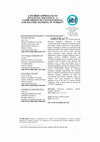
Kafkas Üniversitesi İktisadi ve İdari Bilimler Fakültesi Dergisi, Dec 28, 2023
In this study, the financial soundness indicators of both conventional banks (referred to as depo... more In this study, the financial soundness indicators of both conventional banks (referred to as deposit banks) and Islamic banks (referred to as participation banks) operating in Turkey are analyzed using different methods. The research utilizes financial ratios from the years 2017 to 2022, with the chosen financial ratios aligned with the Bankometer method. Ranking methods such as ARAS, CoCoSo, COPRAS, MABAC and TOPSIS are applied, and the ranking results are combined with the Borda Count method. The findings reveal a robust and healthy level of financial soundness among the analyzed banks, notably highlighting the superior performance of private conventional banks in financial soundness rankings. Importantly, this research makes a valuable contribution by showcasing the financial stability exhibited by both the conventional and Islamic banking sectors in Turkey, even when subjected to different methods, even in the face of adverse global conditions, such as those observed during the COVID-19 pandemic.
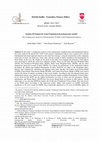
Turkish studies - economics, finance, politics, 2020
In this study, a comparative analysis of the capitalization-weighted index and fundamental indexe... more In this study, a comparative analysis of the capitalization-weighted index and fundamental indexes have been made for the period 2011-2019. In the analysis, fundamental indexes were created in line with the fundamental indexation approach (known as the smart beta strategy), using the internal data of the companies (total sales revenue, net profit-loss, book value, and the average of these) included in the Participation 30 Stock Index. In this way, the weights of the stocks in the index were changed and alternative stock indexes were developed in which the stocks have different weights. These are the Sales Revenue-Weighted Index (SGTE), Net Profit/Loss-Weighted Index (KZTE), Book Value-Weighted Index (DDTE), and the index obtained by taking the average of these (ORTE). To evaluate the performance of the fundamental indexes developed, the market-cap-weighted Participation 30 index (KAT30) was taken as the benchmark index. Indexes were compared by calculating risk-adjusted return ratios. Besides, the Capital Asset Pricing Model (CAPM), Fama-French Three-Factor Model (FF3FM), and Carhart Four-Factor Model (C4FM) were used to analyze the returns of indexes according to their factor models. According to the risk-adjusted return ratios, fundamental indexes were found to be more efficient than the market-weighted Participation 30 Stock Index. It was observed that KZTE has the highest performance in terms of return and risk parameters, Sharpe, Information, and Sortino Ratios; KAT30 have the lowest Sharpe Ratio in contrast to other indexes. On the other hand, it was seen that DDTE has highest the CVaR ratio (Conditional Value at Risk). This ratio lowest at the SGTE index. According to the regression results, alphas were positive in CAPM, statistically significant at 5% level except for DDTE, betas statistically significant at 1% level. In FF3FM, alphas are * Bu çalışma 3-4 Kasım 2018 tarihinde İstanbul'da yapılan "Uluslararası İslam Ekonomisi, Finans ve Etik Kongresi'nde" özet bildiri olarak sunulmuştur.
Uluslararası İktisadi ve İdari İncelemeler Dergisi, 2019
Industry 4.0 and Global Businesses
Uploads
Conference Presentations by Ümit Hasan Gözkonan
Books by Ümit Hasan Gözkonan
Papers by Ümit Hasan Gözkonan